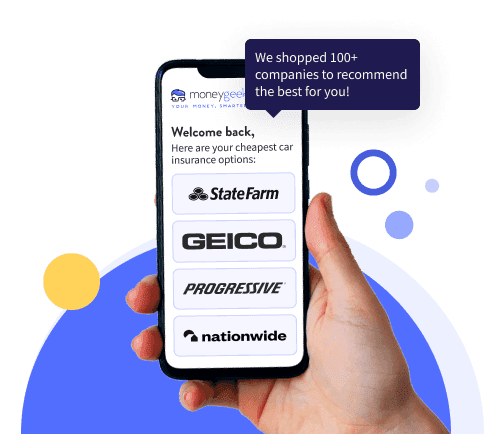Car insurance is required in every U.S. state except New Hampshire, so almost every driver must carry a policy. MoneyGeek has ranked the cheapest car insurance companies for low-income drivers by state and at the national level. If you’re a California, Hawaii or New Jersey resident, you may qualify for a government-sponsored program to help low-income drivers get affordable insurance.
How to Get Car Insurance for Low-Income Drivers
Government-subsidized low-income car insurance is only available in a few states. But no matter the state, there are many ways for low-income drivers to get affordable car insurance to stay safe on the road.

Updated: October 19, 2024
Advertising & Editorial Disclosure
- Cheapest Insurance by State
- Cheapest Insurance Nationally
- State-Funded Low-Income Insurance
- Car Insurance Rates and Your Budget
- Car Insurance Rate Factors
- Does Credit Score Impact Costs?
- How to Lower Your Insurance Premium
- Discount Options for Low Income
- Other Low-Income Options
- FAQs About Low-Income Insurance
- Expert Insights
- Cheapest Insurance by State
- Cheapest Insurance Nationally
- State-Funded Low-Income Insurance
- Car Insurance Rates and Your Budget
- Car Insurance Rate Factors
- Does Credit Score Impact Costs?
- How to Lower Your Insurance Premium
- Discount Options for Low Income
- Other Low-Income Options
- FAQs About Low-Income Insurance
- Expert Insights
Table of Contents
- Cheapest Low-Income Car Insurance by State
- Cheapest Low-Income Car Insurance on a National Level
- State-Funded Low-Income Car Insurance Programs
- How Much Does Car Insurance Cost for Drivers With a Low Income?
- Factors That Impact Your Car Insurance Rates
- Does Your Credit Score Impact Your Car Insurance Cost?
- Tips to Save on Your Premium
- Best Discounts for Low-Income Car Insurance
- Other Options for Low-Income Drivers
- FAQs About Getting Car Insurance for Low-Income Drivers
Key Takeaways
Income isn’t a factor used in calculating your car insurance rates, and you can save by shopping around between companies.
There are state-funded programs in California, Hawaii and New Jersey to help low-income drivers find affordable policies.
Low-income drivers can save by purchasing enough insurance to cover their risks and avoiding coverages they don’t need.
Why Trust MoneyGeek? MoneyGeek gathered quote data from state insurance departments and Quadrant Information Services to determine the most affordable car insurance companies for low-income drivers nationally as well as by state. We also performed original research to look for low-income car insurance assistance programs and more general financial assistance programs to help our readers find the best solution for their budget.
Cheapest Car Insurance Companies for Low-Income Drivers by State
The cheapest car insurance policies for low-income drivers are ones that only meet the minimum liability coverage requirements of your state. But coverage requirements differ in each state, which means that the cheapest liability-only car insurance for you depends on your location.
Excluding USAA, MoneyGeek found that the cheapest widely-available minimum car insurance company in most states is State Farm, which was the cheapest option on average in 15 states. GEICO was also widely affordable, ranking as the cheapest in five states, while Erie comes in third, ranking as the most affordable insurer in four states. American National also ranks as the cheapest in four states.
Military families who are eligible for USAA may find it's the cheapest insurer for military drivers overall and the cheapest in 38 states for those who qualify.
Quotes below are for a 40-year-old driver with a poor credit score. Find your state in the table below to see the applicable annual premium. In the District of Columbia, there are two car insurance providers that tie for offering the cheapest rate.
Cheapest by State for Low-Income Drivers (Excluding USAA)
| Alabama | Cincinnati Insurance | $201 |
| Alaska | State Farm | $322 |
| Arizona | Mercury | $305 |
| Arkansas | State Farm | $232 |
| California | GEICO | $419 |
| Colorado | American National P&C | $216 |
| Connecticut | GEICO | $319 |
| Delaware | Travelers | $464 |
| District of Columbia | GEICO | $372 |
| District of Columbia | Chubb | $372 |
| Florida | GEICO | $485 |
| Georgia | Auto-Owners Insurance Co | $311 |
| Hawaii | GEICO | $217 |
| Idaho | American National P&C | $127 |
| Illinois | Mercury | $226 |
| Indiana | Auto-Owners Insurance Co | $228 |
| Iowa | State Farm | $144 |
| Kansas | Nationwide | $221 |
| Kentucky | Cincinnati Insurance | $257 |
| Louisiana | Louisiana Farm Bureau | $484 |
| Maine | Countryway Insurance | $221 |
| Maryland | Kemper | $538 |
| Massachusetts | State Farm | $221 |
| Michigan | Travelers | $101 |
| Minnesota | Westfield | $317 |
| Mississippi | Direct General Insurance | $275 |
| Missouri | State Farm | $388 |
| Montana | State Farm | $168 |
| Nebraska | American National P&C | $138 |
| Nevada | CSAA | $444 |
| New Hampshire | State Farm | $247 |
| New Jersey | GEICO | $428 |
| New Mexico | State Farm | $254 |
| New York | Kemper | $464 |
| North Carolina | Nationwide | $242 |
| North Dakota | Nodak Mutual | $190 |
| Ohio | Erie | $176 |
| Oklahoma | State Farm | $215 |
| Oregon | State Farm | $381 |
| Pennsylvania | Erie | $238 |
| Rhode Island | State Farm | $344 |
| South Carolina | American National P&C | $251 |
| South Dakota | Farmers Mutual of Nebraska | $207 |
| Tennessee | Auto-Owners Insurance Co | $207 |
| Texas | State Farm | $321 |
| Utah | Farmers Union Insurance | $388 |
| Vermont | State Farm | $198 |
| Virginia | American Family | $243 |
| Washington | PEMCO | $262 |
| West Virginia | Erie | $303 |
| Wisconsin | Erie | $230 |
| Wyoming | GEICO | $176 |
State minimum policies do not include comprehensive and collision insurance, which covers the costs of damages to your car. A full coverage policy is more expensive, but low-income drivers with valuable cars should consider paying the extra cost to ensure they have greater financial protection from covered losses. The easiest way to save money on car insurance is to shop around and compare quotes.
Cheapest Car Insurance Companies for Low-Income Drivers Nationally
For low-income drivers looking for the cheapest car insurance companies that are widely available, MoneyGeek calculated the average cost of car insurance on a national level. If you’re eligible, USAA is the cheapest overall, as policies meeting state minimums cost an average of $283 per year.
State Farm is the runner-up, with minimum coverage policies costing an average of $409 per year.
Shopping around is a great way for low-income drivers to save money on car insurance. If you’re saving hundreds of dollars per year on car insurance, you can allocate a bigger share of your income to other needs.
Cheapest Car Insurance Companies for Low-Income Drivers - National
| USAA | $283 |
| State Farm | $409 |
| GEICO | $424 |
| Nationwide | $462 |
| Travelers | $504 |
| Progressive | $514 |
| Farmers | $572 |
| Allstate | $604 |

If you currently serve in the armed forces, are a veteran or a family member of a service member, it’s hard to beat USAA. Policies meeting minimum state requirements cost low-income drivers an average of $283 per year, the lowest in the industry, and customer service is top-notch. USAA provides personalized financial advice as well. The biggest drawback is that non-military members are not eligible.

State Farm charged our sample low-income driver an average of $409 per year, the cheapest company that all drivers are eligible for, and it also has a variety of discounts available. With more than 19,000 agents nationwide, it’s easy to find one near you.

GEICO offers some of the cheapest car insurance rates in almost every state, even for drivers with poor credit. A minimum coverage policy costs low-income drivers an average of $424 per year, among the cheapest of available companies. In addition to the already low rates, the company has a number of discounts available, including for active-duty military and veterans. You can get a quote online that will explain everything the coverage provides.
While it's tempting to zero in solely on affordability when seeking the best low-income car insurance, remember the old adage: "You get what you pay for." Opting for the cheapest option might sometimes mean compromising on service quality. It's crucial to strike a balance between cost and quality. When scouting for insurance, prioritize providers known for both high customer satisfaction and competitive rates. Insurance isn't just a legal checkbox; it's a vital safety net. In the event of accidents, having a reliable insurance policy can significantly alleviate financial burdens associated with damages. So, while budget is essential, ensure you're also investing in peace of mind and protection
State-Funded Low-Income Car Insurance Programs
California, New Jersey and Hawaii have government-sponsored programs to help low-income drivers afford car insurance. They’re worth looking into if you live in one of these states.
However, keep in mind that low-income car insurance programs typically have eligibility requirements associated with the federal poverty level (FPL), which changes yearly. If you are interested in these programs, check to see if your income qualifies before applying.
California's Low-Cost Automobile Insurance Program (CLCA)
The CLCA is a low-income car insurance policy in California. Good drivers within 250% of the federal poverty limit may qualify for this program. It provides liability insurance for a vehicle’s primary driver and eligible secondary drivers. To qualify, you must:
- Have a valid California driver’s license
- Have a good driving record
- Meet income eligibility requirements
- Be at least 16 years old
- Own a car valued at less than $25,000
Liability coverage limits are 10/20/3, meaning $10,000 bodily injury liability per person, $20,000 bodily injury liability per accident and $3,000 property damage liability per accident. That is lower than typical California liability limits but better than driving without insurance.
New Jersey's Special Automobile Insurance Policy (SAIP)
The Special Automobile Insurance Policy (SAIP) is a form of low-income car insurance in New Jersey, otherwise known as the dollar-a-day program. It provides medical-only coverage for low-income drivers. You must be enrolled in federal Medicaid with hospitalization to qualify.
The SAIP covers emergency medical treatment after a car crash, up to $250,000. It also provides a $10,000 death benefit if that accident results in death. It does not provide liability insurance or cover you for doctor’s visits beyond the initial treatment.
Hawaii's Aid to the Aged, Blind and Disabled Program (AABD)
If you’re looking for low-income car insurance in Hawaii, the state offers a program called the Assistance to the Aged, Blind and Disabled (AABD). This can help you get financial assistance for auto insurance, but you must meet one of the following requirements:
- Be 65 or older
- Be legally blind
- Be totally and permanently disabled
- Live with or provide care to someone who receives AABD assistance
- Have an income below 34% of the current Federal Poverty Level
If you qualify, auto insurance is free.
Maryland Automobile Insurance Fund
While there is no program for low-income car insurance in Maryland, the Maryland Automobile Insurance Fund offers insurance to drivers whose automobile insurance applications have been rejected at least twice by private insurers. In particular, drivers can qualify if they:
- Have had a policy be canceled
- Have been rejected by two or more insurance companies for coverage
- Have poor credit or no credit history
- Have traffic violations
- Have a history of lapses in paying for past policies
- Are a high-risk driver
How Much Does Car Insurance Cost for Drivers With a Low Income?
Insurance companies are prohibited from using income as a rating factor when calculating insurance rates, so drivers don’t pay more for car insurance just because they have lower incomes. But low-income drivers pay a higher percentage of their household income toward their car insurance bill. As the table below illustrates, the less money you make, the greater share of your income goes toward your car insurance bill.
For example, a driver making $20,385 a year, the federal low-income designation, will pay 2% of their budget for a GEICO policy only meeting state minimum requirements. If the same driver were making the country’s median household income, which is $70,784 per year pretax, they would only pay 0.6% of their budget toward car insurance for the same policy.
While car insurance may place a heavy burden on your household's budget, it's not wise to cancel it, assuming you can restart coverage when you can afford it. Insurance companies will charge a penalty if you have a lapse in insurance coverage, so you will pay more in the long run. Additionally, you could face substantial fines from your state if you need to reinstate your suspended driver's license and vehicle registration.
Minimum Liability Car Insurance Rates as a Share of Driver Budgets
Company | Annual Premium | Share of Federal Low-Income Designation ($20,385 per year) | Share of Median US Household Income ($70,784 per year) |
|---|---|---|---|
USAA | $283 | 1.4% | 0.4% |
GEICO | $424 | 2% | 0.6% |
Nationwide | $462 | 2.7% | 0.65% |
Travelers | $504 | 2.5% | 0.7% |
Progressive | $514 | 2.5% | 0.73% |
Allstate | $604 | 3% | 0.85% |
State Farm | $409 | 2% | 0.58% |
Farmers | $572 | 2.8% | 0.8% |
Insurance companies differ in how they categorize different neighborhoods and weigh different factors, so it’s still important to shop around to get the best car insurance for you if you have a low income.
What Level of Coverage Do I Need If I Have a Low Income?
Your state’s minimum required amount of liability insurance is the least expensive option. But depending on your state, the liability coverage may be quite low and may not provide the coverage you need. For instance, most states only require $50,000 in bodily injury liability per accident.
Coverage limits on auto insurance policies are typically presented as three numbers with slashes, such as 50/100/50. This represents:
- $50,000 per person for bodily injury coverage
- $100,000 maximum for all personal injuries caused by the incident
- $50,000 for property damage coverage per accident
If you are found at fault in an incident that resulted in injuries that were more expensive than what your policy covers, you may be personally responsible for paying the remaining amount to cover the cost of the settlement. For example, if one individual in the car you hit needs medical care that costs $75,000, but you only have $50,000 per person in bodily injury coverage, you would be responsible for paying the additional $25,000 to cover their medical expenses.
Adding collision and comprehensive insurance to get a full coverage policy will be more expensive but offers the best financial protection. A liability-only policy will only cover the cost of damage and injury to the other car and those riding in it. A full coverage policy will also cover the cost of damages to your vehicle. Companies tend to charge an extra $300 to $500 per year, on average, to add these coverages. Full coverage is typically required if you have a loan or lease on the car, but many drivers should consider buying it even if they aren't required to for a much greater level of financial protection.
At a national level, the average costs of car insurance by policy type and coverage are as follows:
- A state minimum liability-only policy will cost $471 per year.
- A state minimum full coverage policy will cost $909 per year.
- A 100/300/100 liability-only policy will cost $582 per year.
- A 100/300/100 full coverage policy will cost $1,021.
Use the table below to compare the cost of full or minimum coverage in your state.
Average Annual Premiums by Coverage and State
- Alabama
- Alaska
- Arizona
- Arkansas
- California
- Colorado
- Connecticut
- Delaware
- District of Columbia
- Florida
- Georgia
- Hawaii
- Idaho
- Illinois
- Indiana
- Iowa
- Kansas
- Kentucky
- Louisiana
- Maine
- Maryland
- Massachusetts
- Michigan
- Minnesota
- Mississippi
- Missouri
- Montana
- Nebraska
- Nevada
- New Hampshire
- New Jersey
- New Mexico
- New York
- North Carolina
- North Dakota
- Ohio
- Oklahoma
- Oregon
- Pennsylvania
- Rhode Island
- South Carolina
- South Dakota
- Tennessee
- Texas
- Utah
- Vermont
- Virginia
- Washington
- West Virginia
- Wisconsin
- Wyoming
Factors That Impact Your Car Insurance Rates
Your income isn’t a factor in determining your car insurance rates. However, car insurance companies do consider a lot of factors that tend to correlate with income, such as where you live and your level of education, although some states ban the use of these individual rating factors.
What type of car you drive will impact your insurance rates. High-performance, flashy sports cars are always more expensive to insure, as drivers of these cars tend to take more risks.
One reason people with higher incomes tend to get better rates is that they can afford to pay for damages out of pocket, so they don’t have to file a claim for every accident: fewer claims equals lower premiums.
Low-income drivers sometimes have gaps or lapses in their insurance coverage, and this can lead to higher rates. Insurance companies consider people with gaps in coverage as high risk because they think you were still driving even though you had no insurance during these times.
Other factors insurance companies may consider are:
- Vehicle
- State and ZIP code
- Age
- Gender
- Marital status
- Motor vehicle record
- Previous insurance coverage
- Claims history
- Credit history (except in California, Hawaii, Massachusetts and Michigan)
- Average mileage
- Coverage type and deductibles
Does Your Credit Score Impact Your Car Insurance Cost?
Some insurance companies consider credit history or credit-based insurance scores when determining rates. The reasoning is that drivers with low credit scores are more likely to file claims. However, some states have decided this is discriminatory. If you live in California, Massachusetts, Michigan or Hawaii, insurance companies cannot consider your credit history as a determining factor. Your credit will affect your premium if you live in another state. You can still find cheap car insurance if you have poor credit and need insurance.
In the table below, credit scores are defined as:
- Good: 769-794
- Fair: 710-740
- Poor: 524-577
The average credit score is 714, according to Experian.
Average Annual Car Insurance Premiums by Credit Score
| Nationwide | $901 | $75 | $1,218 | $102 |
| Farmers | $1,045 | $87 | $1,599 | $133 |
| State Farm | $787 | $66 | $2,166 | $180 |
| Progressive | $985 | $82 | $1,766 | $147 |
| Travelers | $936 | $78 | $1,578 | $132 |
| USAA | $614 | $51 | $1,105 | $92 |
| GEICO | $795 | $66 | $1,317 | $110 |
| Allstate | $1,008 | $84 | $1,537 | $128 |
Low-Income Car Insurance: Tips to Save on Your Premium
Finding cheap car insurance for low-income drivers may seem a herculean task, but there are many ways you can save money. The easiest way to save money is to shop around. This is also likely to result in the most significant savings, so don’t skip this step.
Here are some other ways to save:
Drive a Cheaper Car to Insure
Some cars are less expensive to insure than others. Luxury vehicles are expensive to repair and cost more to insure. High-performance sports cars are always more expensive to insure because insurance companies associate them with riskier driving. Cars such as the Subaru Outback or Ford Escape are among the cheapest vehicles to insure, according to Car and Driver.
Comparison Shop for Low-Cost Insurance
Comparing quotes from different providers gives you an overview of all your options, letting you choose the best for your profile. To save time, use a car insurance calculator to get a rough estimate of what your policy might cost and look for offers lower or around that.
Compare Auto Insurance Rates
Ensure you're getting the best rate for your auto insurance. Compare quotes from the top insurance companies.
Take Advantage of Discounts
The average car insurance company offers multiple discounts. Some discounts, such as good driver discounts, can save you as much as 30% on your premium. Other discounts save less, but they can still make a difference, and there’s a wide variety of them.
Choose Less Coverage
You will need to purchase at least your state’s minimum required amount of liability insurance. However, these requirements are very low, so if you can afford it, going to the next level of liability insurance is worth it. If your car isn’t worth more than a few thousand dollars, you probably don’t need full coverage. You can also drop roadside assistance and rental car insurance to save money.
Switch to Usage-Based Coverage
If you’re a good driver, consider getting a usage-based auto policy. The way it works is your insurance company uses telematics — either through a mobile app or plug-in device — to track exactly what you do behind the wheel. It monitors things like rapid changes in speed, hard braking and how fast you drive. Keep in mind that telematics programs could result in a higher premium if the schematics reveal you take risks while driving.
Similarly, if you don’t drive much, some companies have low-mileage plans, which only charge you for the miles you drive.
Usage-based programs aren’t available in every state, so check with your insurance company to see what they offer and how the data is used.
Take a Defensive Driving Course
Taking a class in defensive driving techniques can save you some money. It’s best to check with your insurance company before you sign up, as some companies have a pre-approved list of such courses. Plus, you typically need to have a clean driving record (no moving violations or at-fault accidents) for a minimum of three years to be eligible for this discount program. However, even if you don’t get a discount, you can learn skills that make you a better driver, and that will ultimately reduce your premium.
Maintain a Clean Driving Record
It may seem obvious, but good drivers pay less for car insurance. The cost of a speeding ticket can increase your premium by hundreds of dollars a year for a minimum of three years. If you’re already having trouble paying your car insurance bill, you need to be careful while driving. Pay attention to the road: distracted driving kills eight people every day and injures over a thousand across the U.S. And take note, texting and driving is considered a type of distracted driving, and a citation for it can raise your premium.
Pay in Full
If you’re a low-income driver, paying for your auto insurance policy in one lump sum payment may not be realistic, and you may need to use a no-deposit monthly payment cycle to get insured. However, if it’s possible, paying in full may save you somewhere between 5% and 15% a year.
Improve Your Credit Score
Unless you live in a state that doesn’t consider credit history (California, Massachusetts, Michigan and Hawaii), raising your credit score will save you money on car insurance. You can improve your credit score in the long term by paying down debts, consistently making on-time credit card payments and increasing the length of your credit history.
Don’t Let Your Policy Lapse
While it may be tempting to cancel your policy and rebuy it when your budget permits, doing this can be counterproductive. Providers look at policy lapses and tend to charge a higher premium once you decide to buy again. Thus, it’s a better choice, in the long run, to maintain your insurance to avoid an increase in premiums.
Best Discounts for Low-Income Car Insurance
To help their policyholders save, insurance companies often provide a variety of auto insurance discounts that are easy to qualify for. For instance, there are student and senior citizen discounts or discounts for being a good driver. However, not all discounts are offered by all providers — some may have more than others.
Pay-In-Full Discount
If you can pay your premium in full, you can usually save between 5% and 15% a year, depending on the company. You can also get a discount for going paperless or enrolling in autopay.
But keep in mind that if you cannot pay your insurance in full and upfront, you can always ask the insurer if they provide a no down payment policy and pay your premium monthly.
Job-Related Discounts
If you work as a teacher, physician or police officer, you may be eligible for a discount — statistically, these occupations are less likely to file claims. Insurers offer auto insurance discounts for federal employees, engineers and first responders such as nurses.
Additionally, many providers offer military discounts on auto insurance.
Safe Driver Discounts
The easiest way to save money on car insurance is to qualify as a safe driver. People with poor driving records pay more for insurance.
You probably qualify as a good driver if you haven’t had an at-fault accident or gotten a ticket in the last three years. You’re the type of customer insurance companies want to insure, so shop around to get a good rate. If you want to take it a step further, taking a defensive driving course may get you a discount as well.
While attending "traffic school" will prevent a ticket from being applied to your state's motor vehicle record (MVR) point system, it may not prevent a minimum three-year surcharge from being applied to your auto insurance premium bill — all moving violations are reported to your insurer. They decide what increase you may incur, and attending traffic school could make it lower.
If you want to prevent an at-fault accident from raising your insurance premium, consider adding accident forgiveness to your policy (if available). It could stop a premium increase after your first at-fault accident. You can also look for insurers that award it for free, such as GEICO and Progressive. — Mark Friedlander, Director, Corporate Communications, Insurance Information Institute
Good Student Discounts
Some insurers offer car insurance discounts for students, but often have qualifying requirements. For instance, with some providers, students with at least a B average or 3.0 GPA can qualify for a good student discount. You’ll need to provide a transcript or a report card to prove you’re eligible every year. These can save you between 10% and 15%.
Bundling Discounts
Home and auto insurance bundles, or renters insurance instead of home insurance with the same company, can earn you a discount on both policies. This is the company’s way of rewarding you for doing business with them, and the discount could help you save up to 20%.
Other Options for Low-Income Drivers
There are also a few non-state programs to help low-income drivers obtain cheap car insurance.
Citizens United Reciprocal Exchange
Citizens United Reciprocal Exchange is a not-for-profit insurance company. It is available through two subsidiaries: CURE Auto Insurance and NJ PURE for medical malpractice insurance.
If you live in New Jersey or Pennsylvania and you have a good driving record, CURE Auto Insurance may work for you. CURE only considers your driving history when preparing a quote — not your credit score, your ZIP code, your education or anything else. This makes them a perfect option if you have a good driving history and not-so-perfect credit.
Find Charities and Financial Assistance Programs in Your State
Aside from being legally required in most states, car insurance can help drivers financially protect themselves in case of an accident. Maintaining an auto insurance policy can also help drivers avoid premium increases from a lapse of coverage.
However, if staying insured is difficult due to financial strain, many charities and financial assistance programs can help. For instance, you can opt for any of Benefits.gov’s utility and bill assistance programs, which can cover several different monthly bills, such as your electricity, insurance or groceries. However, if you need help with medical debt, you can also apply for medical debt relief programs. This lets you free up income to pay for insurance and other bills.
If you need help finding financial assistance programs near you, use Need Help Paying Bill’s charity locator tool.
Additional Low-Income Resources and Support
Living on a tight budget can be discouraging — but know that there are ways to improve your financial standing. MoneyGeek offers a variety of resources to help you empower your finances, such as learning how to live on a low income, managing financial stress, building positive spending habits and more. Ultimately, these resources can help you take ownership of your finances and life.
Apart from offering general resources, MoneyGeek also provides information dedicated to individuals who require specific types of assistance or financial planning.
- For Women Experiencing Domestic Violence: Financial abuse is one of the most common reasons women stay in abusive relationships or return to them. In this article, learn how to empower yourself to find support and assistance and ultimately regain financial independence.
- For Native American Communities: A number of factors can contribute to the money challenges Native Americans face. By understanding how Native communities build wealth and deal with financial challenges, we can build a more equitable financial foundation across the nation.
- For Formerly Incarcerated People: Getting a job, opening a bank account and finding a safe place to live are all challenges formerly incarcerated individuals face at once. We want to give the formerly incarcerated community a chance to start over by connecting them with support services and providing sound financial advice.
- For Families With Children Who Are Diagnosed With a Chronic or Terminal Illness: Caring for a child with a chronic, or worse, terminal illness can be emotionally and financially draining. Understand how to thrive financially, where to find support programs and how to care for both yourself and your child.
- For Undocumented Immigrants: Being an undocumented immigrant can come with a host of unique financial opportunities and hardships. Discover how to tackle unique challenges, manage your finances, what your rights are and other sources of financial support you can turn to.
- For Individuals With Visual Impairments: People with visual impairments face more challenges navigating a highly visual world. Learn how to find financial assistance if you or a loved one is blind or visually impaired.
- For Refugees in the U.S.: Starting over in an unfamiliar country can be challenging — but know there are steps to take toward a better financial future. As you settle into the U.S., learn about where you can get financial support and assistance as you rebuild your life for the better.
- For Individuals Who Need Health Insurance: Getting health insurance can be a minefield for those who are uninsured. Learn about the different types of healthcare plans, what you’re eligible for and how to find the right one.
Compare Auto Insurance Rates
Ensure you're getting the best rate for your auto insurance. Compare quotes from the top insurance companies.
Frequently Asked Questions About Getting Car Insurance for Low-Income Drivers
MoneyGeek answers frequently asked questions about car insurance for low-income drivers to help you find the most affordable provider and the best deal.
State Farm offers the most affordable auto insurance for most drivers, but keep in mind that this can change based on your needs, such as if you are a young driver, a military member or a driver with an at-fault accident on your record.
The most affordable car to insure is the Honda CR-V, according to MoneyGeek's analysis, whether it is used or new. It is also the cheapest SUV to insure.
Finding the cheapest car insurance quotes involves shopping around and comparing different providers. However, this can be time consuming, so MoneyGeek created a car insurance calculator. Simply fill in the details and get rough estimates in seconds, which can serve as the basis of your research.
Yes. While cheap car insurance can be light on the wallet, it may not provide enough financial protection in case of an at-fault accident. If you only have the minimum liability limits, you could be responsible for paying thousands of dollars to pay for your medical bills and repairs if you get into an at-fault accident and paying the other party's medical bills and repairs out of pocket if you don't have adequate coverage (except in no-fault states).
Read More on Auto Insurance
Expert Advice on Getting Car Insurance for Low-Income Drivers
- Does your income level affect how much car insurance companies charge you?
- What are the risks associated with buying lower coverage to save on my monthly car insurance rate?
- What are the best ways for drivers to lower their rates?






About Gail Kellner

Gail Kellner is a finance writer at MoneyGeek, specializing in life insurance, auto insurance and personal finance. She also has a 23-year experience in the health sector.
Kellner has a Master of Science from Indiana State University and a Bachelor of Arts in Psychology from Western Connecticut State University.
sources
- HealthCare.gov. "Federal Poverty Level (FPL)." Accessed October 19, 2024.
- State of New Jersey Department of Banking and Insurance. "Special Automobile Insurance Policy (SAIP)." Accessed October 19, 2024.
- State of Hawaii Department of Human Services. "Assistance for Aged, Blind, and Disabled (AABD)." Accessed October 19, 2024.
- Maryland Manual On-Line. "Maryland Automobile Insurance Fund." Accessed October 19, 2024.
- United States Census Bureau. "Income in the United States: 2021." Accessed October 19, 2024.
- Experian. "What Is the Average Credit Score in the U.S.?." Accessed October 19, 2024.
- Need Help Paying Bills. "Charities Near You." Accessed October 19, 2024.
- Car and Driver. "Cheapest Cars to Insure." Accessed October 19, 2024.
- Consumer Federation of America. "Auto insurers often charge identical neighbors considerably higher premiums because of ZIP code differences." Accessed October 19, 2024.
- Insurance Information Institute. "Automobile Financial Responsibility by State." Accessed October 19, 2024.













